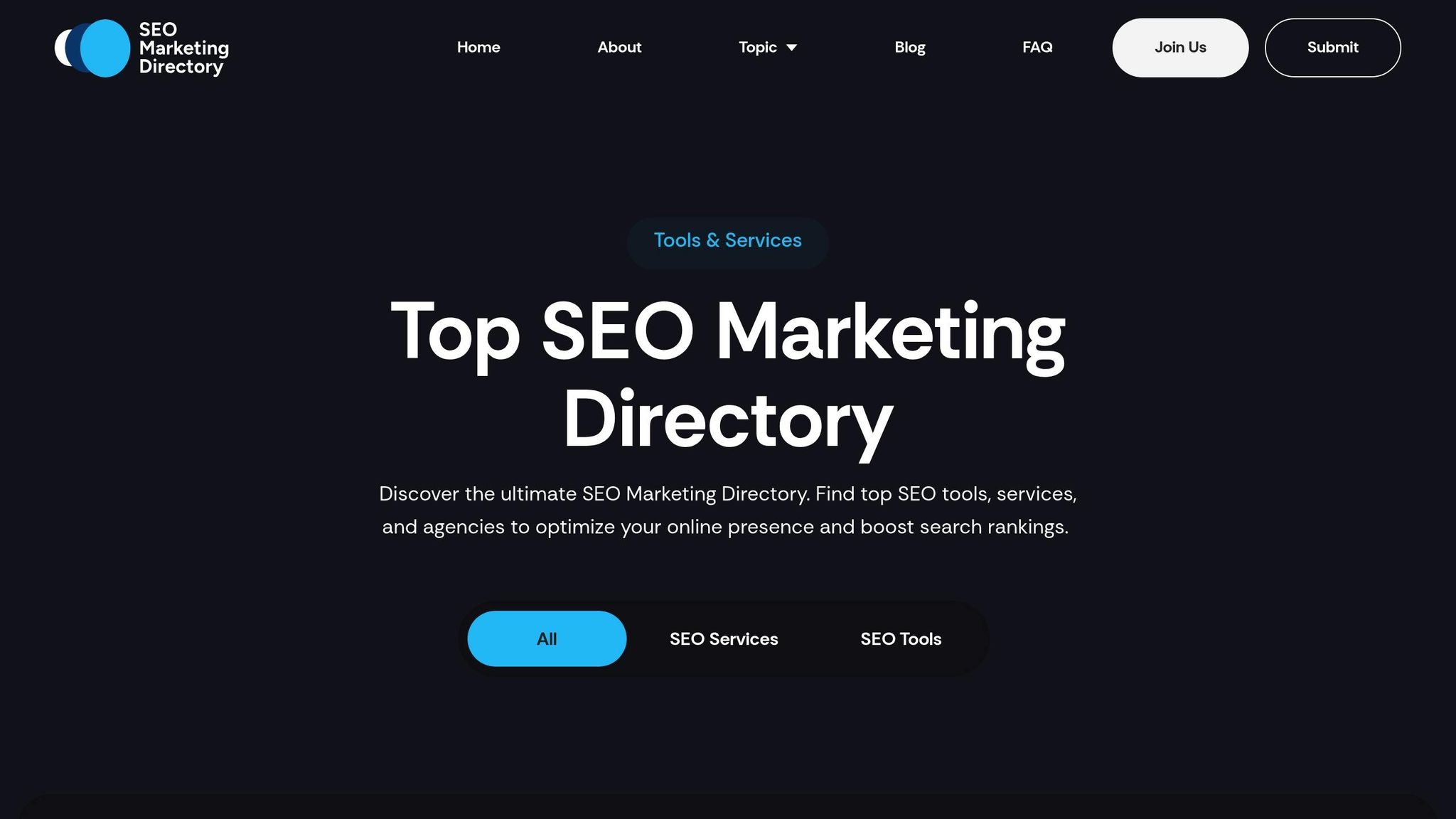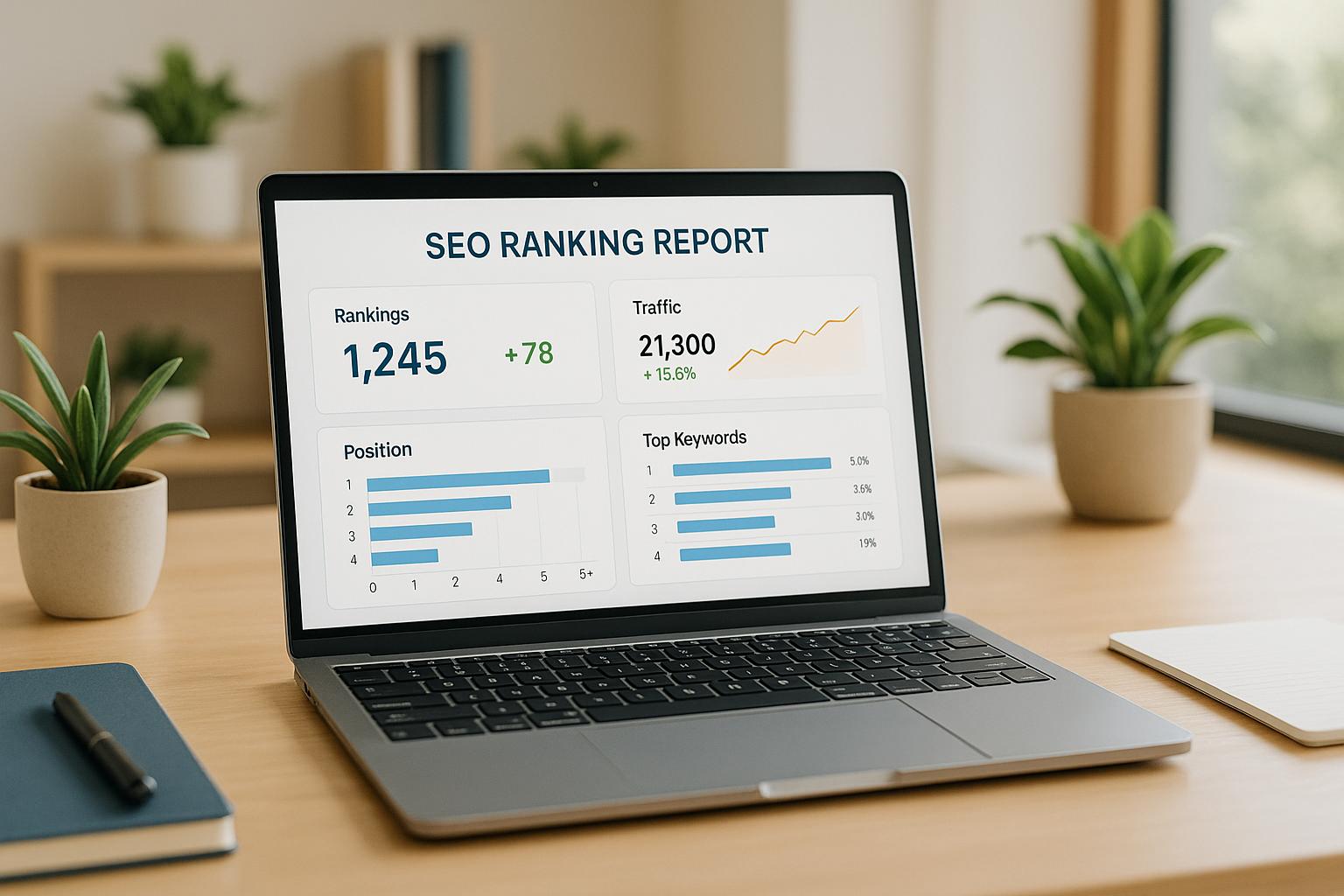Want to know if your local SEO efforts are paying off? Calculating ROI (Return on Investment) is the best way to measure how much revenue your campaigns generate compared to what you spend. Here’s the formula:
ROI = [(Revenue - Cost) / Cost] × 100
For example, if you spend $2,000 on local SEO and earn $8,000 in revenue, your ROI is 300%. Local SEO focuses on attracting nearby customers who are often ready to buy, making it a highly effective strategy for businesses targeting specific areas.
Key Takeaways:
- Why ROI Matters: It helps justify your budget and shows which strategies work best.
- Revenue Sources: Increased foot traffic, online sales, phone calls, and brand recognition.
- Metrics to Track: Local website traffic, conversion rates, and Customer Lifetime Value (CLV).
- Tools to Use: Google Analytics 4, Google Business Profile Insights, and call tracking software.
- Cost vs. Revenue: Typical local SEO costs range from $500 to $4,000/month.
By tracking costs, revenue, and using the right tools, you can clearly see the impact of your local SEO campaigns and adjust for better results.
The ROI Secret for Marketing Agencies What Your Clients Will Pay
Key Metrics and Data Sources for Local SEO ROI
Now that the basics of ROI are clear, let’s dive into the specific metrics and data sources that help measure the impact of local SEO. To truly understand what’s working, you need to track the right numbers and use reliable tools to pinpoint which strategies are delivering results.
Metrics That Matter for Local SEO ROI
The cornerstone of local SEO ROI measurement is tracking revenue from local search conversions - both online and offline. This means identifying sales directly tied to customers who discovered your business through local search results. Whether it’s an online purchase or a physical store visit, these conversions are essential to understanding your ROI.
Metrics from your Google Business Profile offer valuable insights. Every action - like calls, clicks, or direction requests - plays a role in calculating your ROI.
- Local website traffic: This metric reveals how many visitors land on your site from local search queries. Segmenting this traffic by geographic location helps you see which neighborhoods or cities are driving the most engaged visitors.
- Conversion rates: Local searchers often have higher intent compared to general website visitors. Tracking how these users convert - whether through purchases, calls, or form submissions - provides a clearer picture of your local SEO’s effectiveness.
- Customer Lifetime Value (CLV): This metric adds depth to your ROI analysis. For instance, a customer who initially spends $500 after finding you via local search might generate $2,000 in revenue over the course of their relationship with your business.
Key Data Sources for ROI Tracking
To measure ROI effectively, you’ll need to tap into the right tools and platforms. Here are some of the most reliable data sources for local SEO performance:
- Google Analytics 4 (GA4): This is your go-to hub for tracking local SEO metrics. Set up goals specific to local actions, like click-to-call buttons, contact form submissions, or direction requests. Create custom dashboards to monitor traffic by city or zip code, as well as local conversions and top-performing pages.
- Google Business Profile Insights: This platform provides detailed data on how customers engage with your listing. Metrics like search views, calls, direction requests, and website clicks give you a direct look at how local SEO efforts are paying off.
- UTM parameters: Adding UTM codes to URLs in your Google Business Profile - such as website links or booking pages - helps you track exactly which sources drive traffic and, more importantly, conversions.
- Google Search Console: When integrated with GA4, this tool provides keyword-level data. You’ll see which local search terms bring traffic, how your pages rank, and where there’s room to improve click-through rates.
By combining these data sources, you’ll have a solid foundation to assess your local SEO efforts and identify areas for improvement.
Tools for Tracking Local SEO Performance
Once you’ve gathered data from the sources above, specialized tools can make tracking and analyzing your local SEO performance much easier. These tools centralize information, automate reporting, and help you measure ROI more accurately.
- Call tracking software: Tools like CallRail or CallTrackingMetrics let you assign unique phone numbers to different local SEO channels. For example, you can use one number for your Google Business Profile and another for your website, allowing you to track exactly how many phone conversions each channel generates.
- Google Tag Manager (GTM): GTM simplifies tracking by letting you deploy and manage codes for events like form submissions or button clicks. It integrates seamlessly with GA4, ensuring precise data collection without slowing down your website.
- Heat mapping tools: Platforms like Hotjar or Crazy Egg provide visual insights into how local users interact with your site. By identifying areas where visitors drop off or engage most, you can optimize your landing pages to boost conversions.
These tools don’t just streamline data collection - they also help you connect the dots between user behavior, geographic performance, and revenue. For example, you can differentiate traffic sources to attribute revenue directly to local SEO efforts, such as Google Business Profile interactions.
Automation features are another game-changer. Instead of manually gathering data from multiple platforms, you can set up automated reports that clearly show how your local SEO investments translate into measurable business outcomes. Whether it’s tracking calls, form submissions, or in-store visits, these tools ensure that you’re always equipped with the insights needed to refine your strategy and maximize ROI.
Calculating Local SEO Costs and Revenue
Let’s dive into how you can break down the costs of local SEO and measure the revenue it generates. With local SEO expenses climbing by about 18% since 2023 - thanks to growing competition and increasingly complex algorithms - keeping a close eye on these numbers is more crucial than ever.
Local SEO Campaign Costs
Local SEO budgets typically fall between $500 and $4,000 per month, depending on the scale of the campaign. Startups often spend between $500 and $1,200, while larger, enterprise-level campaigns can exceed $5,000 monthly. These costs include both direct expenses like agency fees, SEO tools, and content creation, as well as indirect ones such as internal labor, training, and website upkeep.
Measuring Revenue from Local SEO
To understand the revenue impact of local SEO, it’s essential to link online actions to tangible business outcomes. A well-optimized local search presence can drive both online and offline conversions.
For online conversions, tools like Google Analytics 4 help track metrics such as e-commerce sales, lead generation, click-to-call interactions, and appointment bookings. Offline conversions, while trickier to measure, can’t be ignored. Research shows that 80% of mobile-based local searches lead to transactions, highlighting how a strong local search strategy can directly influence in-person sales.
To get a fuller picture of revenue, consider Customer Lifetime Value (CLV). This metric captures the total revenue a customer brings to your business over time. An effective local SEO campaign doesn’t just bring in new customers - it can also boost the value of existing ones.
Cost and Revenue Analysis Overview
To evaluate the success of your local SEO investment, compare your monthly costs against both online and offline revenue. Whether your focus is on short-term revenue growth or maximizing long-term customer value, a detailed analysis will provide the insights you need. These numbers feed directly into your ROI calculations, tying back to the formula discussed earlier in the article.
sbb-itb-5be333f
Step-by-Step ROI Calculation Process
With your cost and revenue data ready, calculating ROI for local SEO becomes a straightforward process. By applying a clear formula to your specific situation, you can effectively measure the success of your efforts.
The ROI Formula for Local SEO
At its core, ROI calculation boils down to a simple formula that compares your gains to your investment:
ROI = [(Revenue from Local SEO – Cost of Local SEO) / Cost of Local SEO] × 100
This formula gives you a percentage that represents the return on every dollar spent on local SEO. A positive ROI (like 150% in the example below) indicates profitability, while a negative ROI shows that returns fell short of the investment.
Here’s an example: If your local SEO campaign generated $15,000 in revenue over six months and cost you $6,000, the calculation would look like this:
ROI = [($15,000 – $6,000) / $6,000] × 100 = 150%
In this scenario, you’re earning $1.50 for every $1.00 spent on local SEO.
ROI Calculation Instructions
To ensure an accurate ROI calculation, start by gathering all costs related to your local SEO efforts. This includes expenses like agency fees, software subscriptions, content creation, and internal labor. Make sure your cost and revenue data align within the same time frame - whether that’s monthly, quarterly, or annually.
Next, collect revenue data from both online and offline sources. Tools like Google Analytics 4 can help you track online conversions, such as e-commerce sales, lead form submissions, and phone calls. For offline revenue, identify customers who found you through local search. Don’t forget to factor in Customer Lifetime Value (CLV) to account for long-term benefits.
Once you have all the data, plug the total revenue and costs into the formula. A higher ROI generally reflects a more successful campaign, though what qualifies as "acceptable" ROI will depend on your business goals. Keep in mind that local SEO often takes months to show its full potential, so early ROI numbers may not tell the whole story. Regularly compare data over time to track progress and identify trends.
Comparing ROI Scenarios with Tables
Using tables to compare ROI metrics across different time frames or locations can help you spot patterns and make smarter budgeting decisions. Here’s an example:
| Time Period | Total Costs | Revenue Generated | ROI Percentage | Notes |
|---|---|---|---|---|
| Month 1–3 | $3,600 | $2,100 | -41.7% | Early investment phase |
| Month 4–6 | $3,600 | $8,400 | 133.3% | Initial results appear |
| Month 7–12 | $7,200 | $18,600 | 158.3% | Growth stabilizes |
This table shows that while the initial months might yield lower returns due to upfront investments, the ROI improves as your local SEO campaign gains traction. You can also use similar comparisons to assess performance across various locations or specific strategies. By reviewing these metrics, you can validate your investment in local SEO and refine your budget allocation.
Sustained positive ROI over time is a strong indicator that your local SEO strategy is paying off and warrants continued or increased investment.
Tools and Resources for Tracking Local SEO ROI
Measuring ROI accurately is a game-changer when it comes to fine-tuning your local SEO strategy. To get the clearest picture, use tools that track both online and offline conversions while delivering performance insights you can act on.
Best Tools for ROI Tracking
Google Analytics 4 is a must-have for tracking website traffic, conversion events, and revenue attribution. You can set specific goals - like form submissions, phone calls, or online purchases - to see how your efforts translate into measurable results. Its advanced e-commerce tracking even highlights which keywords and pages are driving revenue.
Google Business Profile Insights gives you a closer look at how customers interact with your business listing. Metrics like search views, website clicks, direction requests, and phone calls can reveal the offline impact of your local SEO, especially for physical locations.
Call tracking software is essential for businesses relying on phone leads. By assigning unique phone numbers, tools like CallRail and CallTrackingMetrics let you directly connect phone calls to your local SEO campaigns, making it easier to see their value.
CRM systems such as HubSpot or Salesforce help you track leads from the first interaction all the way to a sale. When integrated with Google Analytics, these tools allow you to calculate the lifetime value of customers brought in through local SEO.
Rank tracking tools keep tabs on your local search visibility across different locations and keywords. While rankings alone don’t directly equate to revenue, they provide valuable context for understanding ROI trends and fluctuations.
Using the Top SEO Marketing Directory

The Top SEO Marketing Directory is a go-to resource for discovering highly-rated SEO tools and services, including those tailored to local SEO. It organizes solutions for areas like technical SEO, content optimization, and local SEO, making it easier to find tools that align with your ROI tracking needs.
The directory offers free access, with a premium option at $49/month. Premium users benefit from detailed pricing breakdowns, feature comparisons, and user reviews. For larger businesses, enterprise solutions provide customized options to meet specific needs.
Maximizing ROI for Local SEO Campaigns
To get the most out of your local SEO efforts, it’s important to focus on strategies that not only enhance performance but also ensure your investment delivers measurable returns.
Key Points for ROI Calculation
Accurately calculating ROI begins with detailed tracking of all costs - this includes agency fees, technical optimizations, and any other expenses. At the same time, it’s critical to connect your local SEO efforts to both online and offline conversions. Whether it’s phone calls, form submissions, in-store visits, or online purchases, tying these actions back to your campaigns helps you see the full picture. This is especially important for brick-and-mortar businesses where customers often research online before buying in person.
Consistency in your measurement intervals is another essential factor. Many businesses find that reviewing ROI monthly helps identify trends early, while quarterly evaluations provide a broader view of seasonal shifts and overall performance.
Don’t overlook the long-term value of customers gained through local SEO. A customer’s lifetime value - the revenue they generate over time - often far surpasses their initial purchase. Including this metric in your ROI calculations gives a more accurate representation of your campaign’s success.
Once you’ve established a solid framework for measuring ROI, the next step is implementing strategies to maximize it.
Making Smart Investments in Local SEO
To improve ROI, consider investing in tools that provide actionable insights, such as advanced analytics, call tracking, and rank monitoring software. These tools give you the data you need to fine-tune your campaigns for better results.
The Top SEO Marketing Directory can be a valuable resource when selecting tools and services for your local SEO efforts. With curated listings, it simplifies the process of finding the right solutions to enhance your investment’s impact.
Partnering with the right agency can also make a big difference. Look for agencies with a strong track record in local SEO and a commitment to transparent reporting. The directory’s agency listings can help you identify partners who consistently deliver measurable outcomes.
Efficiency tools, such as marketing automation platforms, local listing management systems, and reporting dashboards, can streamline your workflow. By automating repetitive tasks, you’ll save time and reduce labor costs, allowing you to focus on strategic initiatives. Faster implementation of optimizations can also lead to quicker returns, further boosting your ROI.
A balanced approach is key to long-term success. Quick wins - like optimizing your Google Business Profile - can provide immediate results, but foundational improvements, such as ongoing content creation, technical upgrades, and reputation management, are essential for sustained growth. Allocating your budget across both short-term gains and long-term strategies ensures that your returns continue to grow over time.
FAQs
How do I track offline conversions from my local SEO campaigns?
To measure offline conversions from your local SEO efforts, you can integrate offline conversion tracking by syncing data from tools like your CRM, call tracking software, or point-of-sale systems with your online campaigns. For example, you can match customer details or unique IDs collected offline with data from your website or digital ads.
You can also assign unique user IDs to website visitors or use specific call tracking numbers. These strategies help tie offline actions - such as purchases or inquiries - back to your SEO campaigns. This approach provides a more complete view of your campaign's performance by linking online interactions to offline outcomes.
What challenges do businesses often face when calculating ROI for local SEO campaigns?
Calculating the ROI of local SEO campaigns comes with its fair share of challenges. One of the biggest hurdles is the time lag between rolling out SEO strategies and seeing tangible results. This delay makes it tricky to directly tie conversions to your SEO efforts.
Another obstacle is attribution. Customers often engage with multiple marketing channels before making a decision, which complicates determining how much of the credit belongs to SEO. On top of that, measuring offline outcomes - like in-store visits driven by online searches - can be tough. Add the complexity of modern customer journeys, and it becomes clear why calculating ROI for local SEO requires detailed tracking and thoughtful analysis.
How does Customer Lifetime Value (CLV) affect ROI for local SEO campaigns?
Customer Lifetime Value (CLV) is a key metric when it comes to measuring the ROI of local SEO campaigns. It shifts the focus from short-term wins to the bigger picture - how much revenue a customer generates over their entire relationship with your business.
By considering CLV, you gain a clearer understanding of how your local SEO efforts contribute to attracting and retaining high-value customers. This perspective not only helps refine your strategies but also ensures resources are allocated wisely, leading to a more impactful return on investment (ROI).


